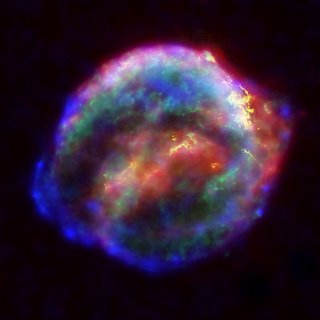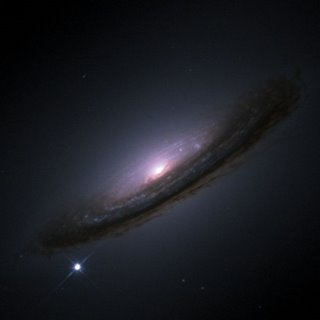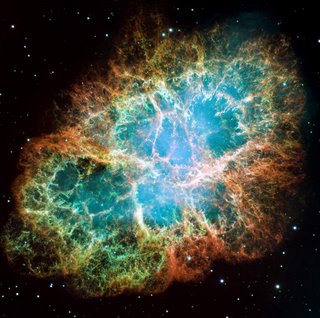Supernova - A stellar explosion which produces an extremely bright object made of plasma that declines to invisibility over weeks or months. A high-mass star dies in the cataclysmic explosion of a supernova, scattering newly produced elements into space and leaving a neutron star or black hole behind. The supernova occurs after fusion begins to pile up iron in the high-mass star's core. Because iron fusion cannot release energy, the core cannot hold off the crush of gravity for long. In the instant that gravity overcomes degeneracy pressure, the core collapses and the star explodes.
 Multiwavelength X-ray image of the remnant of Kepler's Supernova, SN 1604. No supernova seen in our galaxy since then.
Multiwavelength X-ray image of the remnant of Kepler's Supernova, SN 1604. No supernova seen in our galaxy since then. SN 1994D in the NGC 4526 galaxy (bright spot on the lower left). Image by NASA, ESA, The Hubble Key Project Team, and The High-Z Supernova Search Team from Wikipedia. Beautiful isn't it? :D
SN 1994D in the NGC 4526 galaxy (bright spot on the lower left). Image by NASA, ESA, The Hubble Key Project Team, and The High-Z Supernova Search Team from Wikipedia. Beautiful isn't it? :D The Crab Nebula (Taurus constellation) is a pulsar wind nebula associated with the 1054 supernova. This is the most famous supernova remnant. :)
The Crab Nebula (Taurus constellation) is a pulsar wind nebula associated with the 1054 supernova. This is the most famous supernova remnant. :)There are several different types of supernovae. (Type I & Type II). The explosion drives a blast wave into the surrounding space, forming a supernova remnant. One example of this process is the remnant of SN 1604.
A near-Earth supernova is an explosion resulting from the death of a star that occurs close enough to the Earth (roughly fewer than 100 light-years away) to have noticeable effects on its biosphere. Gamma rays are responsible for most of the adverse effects a supernova can have on a living terrestrial planet. In Earth's case, gamma rays induce a chemical reaction in the upper atmosphere, converting ozone into nitrous oxide, depleting the ozone layer enough to expose the surface to harmful solar and cosmic radiation. The gamma ray burst from a nearby supernova explosion has been proposed as the cause of the end Ordovician extinction, which resulted in the death of nearly 60% of the oceanic life on Earth. Speculation as to the effects of a nearby supernova on Earth often focuses on large stars, such as Betelgeuse, a red supergiant 427 light-years from Earth which is a type II supernova candidate.
Hahaha...what I learn here is not only about Supernova. I realise something this beautiful can be so dangerous too (remember supernova is an EXPLOSION). Hahaha...like what the astronomers had said before, the universe is certainly not a safe place at all ya? :P Thank God for keeping Earth safe so far for so many millions of years as it rotates in this danger zone...lol
"The above passage is from Wikipedia. More about Supernova can be found through this link http://en.wikipedia.org/wiki/Supernova :)"



No comments:
Post a Comment